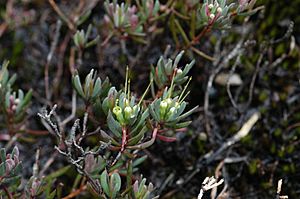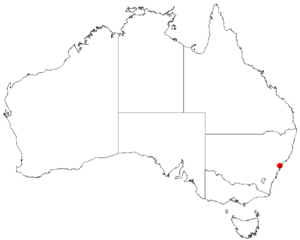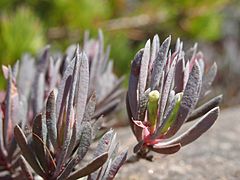Darwinia glaucophylla facts for kids
Quick facts for kids Darwinia glaucophylla |
|
|---|---|
 |
|
| Scientific classification | |
| Genus: |
Darwinia
|
| Species: |
glaucophylla
|
 |
|
| Where this plant grows in Australia | |
Darwinia glaucophylla is a special plant from the myrtle family (Myrtaceae). It grows flat along the ground like a mat, sometimes covering large areas. This plant has cool bluish-green leaves and white flowers. As the flowers get older, they change color to a reddish-pink.
You can only find Darwinia glaucophylla in about fifteen places near the Gosford area in New South Wales, Australia. Because it's so rare, it's officially listed as "threatened" by the laws in New South Wales. This means it needs protection to survive.
Contents
What Does Darwinia glaucophylla Look Like?
Darwinia glaucophylla is a plant that mostly grows flat on the ground. However, it also has some upright branches that can reach about 15 cm (6 in) tall.
Leaves and Flowers
Its leaves grow in pairs on opposite sides of the stem. They are a bluish-green color with a hint of red. The leaves are smooth (meaning they don't have hairs) and are about 8–17 mm (0.3–0.7 in) long. If you cut across a leaf, it would look like a triangle.
The flowers usually grow in small groups of two to four. Each group sits on a tiny stalk about 1 mm (0.04 in) long. There are special leaf-like parts called bracts around the flowers, which are about 8–12 mm (0.3–0.5 in) long. There are also smaller reddish-brown parts called bracteoles, but these fall off as the flowers open up.
The bottom part of the flower, called the floral cup, is about 7–8 mm (0.28–0.31 in) long and 1 mm (0.04 in) wide. It has clear ridges. The sepals (small leaf-like parts that protect the bud) are very short, less than 0.5 mm (0.02 in) long. They are much shorter than the petals (the colorful parts of the flower).
A long, straight, white part called the style sticks out from the flower. It is about 12–16 mm (0.5–0.6 in) long. This plant flowers from July to November. After flowering, it produces tiny seed pods called capsules. Each capsule holds just one small seed, about 1.5 mm (0.06 in) across.
Gallery
- Typical leaf colour & habitat
How Darwinia glaucophylla Got Its Name
This plant was first officially named and described in 1962 by a scientist named Barbara Briggs. She found a sample of the plant near Kariong. Her description was published in a scientific journal called Contributions from the New South Wales National Herbarium.
The second part of its scientific name, glaucophylla, comes from two Ancient Greek words. "Glaukos" means "bluish-green" or "gray," and "phyllon" means "leaf." So, its name basically means "bluish-green leaf," which perfectly describes its unique leaf color!
Sometimes, this plant can mix with another species called D. fascicularis to create hybrids. These hybrid plants are easy to spot because they grow more upright instead of flat on the ground.
Where Darwinia glaucophylla Lives
Darwinia glaucophylla likes to grow in areas with heathland and open forests. It prefers soils that come from sandstone. As mentioned, it's only found in about fifteen locations. These spots are mainly near Calga, Kariong, and Somersby in New South Wales.
Protecting Darwinia glaucophylla
Darwinia glaucophylla is listed as "threatened" under the New South Wales Biodiversity Conservation Act 2016. This means it's in danger and needs help to survive.
Main Dangers to the Plant
- Habitat damage: Its natural home is getting damaged.
- Wrong fires: The way fires happen in its habitat (either too often or not often enough) can harm the plant.
- Sand mine expansion: A nearby sand mine is getting bigger, which takes away more of its living space.
Some studies suggest that cutting the plant (like mowing) and using controlled burning in the right way might actually help this species grow and thrive.



